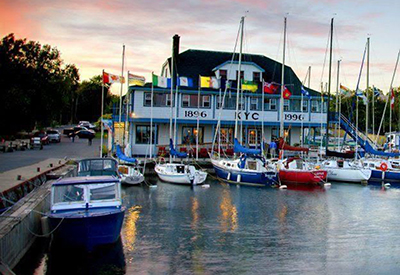Queen City Yacht Club

By Katherine Stone
Imagine a club that has been around for 125 years, that used to rent their club house, finally built a club house only to have it go headfirst into the lake, that rebuilt the clubhouse on an island that didn’t used to exist, and then not be able to get there unless you whistled to someone from across the inlet at Ward’s Ferry, to come get you in a rowboat! Sounds unbelievable…it’s the legacy of the Queen City Yacht Club
In 1793 Lieutenant-Governor Simcoe and his wife used to picnic on the island, although it was really not an island at that time, rather a peninsula coming out from the eastern end of the city. As the only way into the harbour was through the western gap, he decided to make Toronto (then York) the military centre of Upper Canada and Gibraltar Point (now Hanlan’s Point) would guard the entrance. Fort York would eventually be built across the western gap to help defend the city. The area was known to the Mississauga natives as “the place of trees standing out of the water.” It had been made up over a millennia from alluvial deposits carried west from the Scarborough Bluffs, helped with the flow of the Niagara and Don Rivers. A violent storm occurred in 1858, which forever separated the “peninsula” from the mainland creating a crescent shaped chain of islands, curving into an 8 km hook, broken on the inside into tiny lagoons and islets.
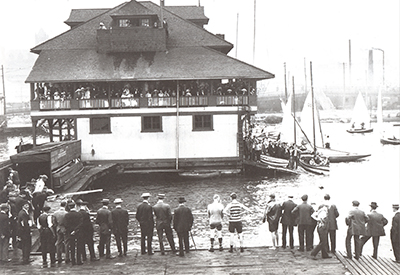 From their meager beginnings of rented boathouses near the foot of York Street to their permanent home on Algonquin Island in Toronto, Queen City Yacht Club has had a vibrant history with a culture of sharing in the club’s work. Originally part of the Toronto Yacht Club in 1880s, a group of young men who wanted to form an affordable club of their own was inspired by the name Queen City of the Lake, which people were then calling Toronto. A month after official incorporation as a club on July 17, 1889, the local newspaper wrote that “QCYC boasted 60 members and some 20 boats.” Racing was the primary reason that men joined the club and by November of that year were also members of LYRA (Lake Yacht Racing Association) which is still in existence today. Things were booming, so another building was acquired next door on Clindinning Row south of the old Union Station (dismantled in 1928). Within a couple of years, facilities were rented from the Toronto Canoe Club just west of the foot of York Street.
From their meager beginnings of rented boathouses near the foot of York Street to their permanent home on Algonquin Island in Toronto, Queen City Yacht Club has had a vibrant history with a culture of sharing in the club’s work. Originally part of the Toronto Yacht Club in 1880s, a group of young men who wanted to form an affordable club of their own was inspired by the name Queen City of the Lake, which people were then calling Toronto. A month after official incorporation as a club on July 17, 1889, the local newspaper wrote that “QCYC boasted 60 members and some 20 boats.” Racing was the primary reason that men joined the club and by November of that year were also members of LYRA (Lake Yacht Racing Association) which is still in existence today. Things were booming, so another building was acquired next door on Clindinning Row south of the old Union Station (dismantled in 1928). Within a couple of years, facilities were rented from the Toronto Canoe Club just west of the foot of York Street.
Reccurring themes, encountered by many clubs, that would last decades began to emerge. Some of these included disagreements 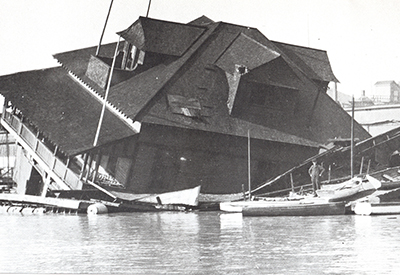 with the Royal Canadian Yacht Club (across the adjoining slip), club finances, and assessments. Also, this was at that time, a man’s sport. Being standard for the time, ladies were not encouraged to visit, their amenities were sparse, and of course, they were not allowed to become members.
with the Royal Canadian Yacht Club (across the adjoining slip), club finances, and assessments. Also, this was at that time, a man’s sport. Being standard for the time, ladies were not encouraged to visit, their amenities were sparse, and of course, they were not allowed to become members.
In it’s very first year, QCYC held weekly races, leaving from the foot of York Street, rounding the Gibraltar Point buoy, to the eastern end of the harbor, and back to the start. On the occasion when RCYC and QCYC did work together, they managed to thwart the Toronto Harbour Trust’s (now the Toronto Port Authority) idea of restricting racing in the harbor and fining yachts for meddling with Steamer traffic. However, they did have quite a row over who could use the harbor on what night and ended up splitting the harbor racing area in half.
The opening of the splendid new $2,000 three-story E.J. Lennox-designed (architect and club member who helped create Toronto City Hall and Casa Loma) clubhouse in 1902 on the property rented from the Argonaut Rowing Club, on their wharf at the foot of York Street,  solidified Queen City’s emergence as one of the leading clubs on Lake Ontario’s waterfront. Ladies could now be invited by members to the club balcony on Saturdays and race days. At that time, aside from sailboat racing, smoking concerts were the rage. As club rule #7 strictly forbade the drinking of spirits and gambling on club grounds, smoking filled the void at $2 a pop. Soon with a profit of $45, funds were put toward renovating the ladies’ parlour. By 1909 dues had shot up to $10 with close to 190 members. However, in a step backward, ladies had lost the privilege of even using the members’ balcony, as the club had gained and retained the reputation for enjoying a good party!
solidified Queen City’s emergence as one of the leading clubs on Lake Ontario’s waterfront. Ladies could now be invited by members to the club balcony on Saturdays and race days. At that time, aside from sailboat racing, smoking concerts were the rage. As club rule #7 strictly forbade the drinking of spirits and gambling on club grounds, smoking filled the void at $2 a pop. Soon with a profit of $45, funds were put toward renovating the ladies’ parlour. By 1909 dues had shot up to $10 with close to 190 members. However, in a step backward, ladies had lost the privilege of even using the members’ balcony, as the club had gained and retained the reputation for enjoying a good party!
In 1912 the Toronto Harbour Commission started an expansion program designed to deepen the harbor for larger commercial vessels and then to use the newly created land from the dredging to expand the waterfront shoreline. According to the book put together by Wayne Lilley, a member for the Centennial, in the process of dredging, “at about 2:30 a.m. on July 7, 1920, the pilings beneath the clubhouse gave way and the three-story clubhouse sagged into the harbor up to about the top of the first story.” Fortunately, the club was already considering a move to Sunfish Island, which ironically, had been created by the harbour’s dredging. At that  time the only other inhabitants of the island were a YMCA boys’ camp and an airplane hangar at the far western edge. By 1938 Sunfish Island had been renamed Algonquin Island and there were some houses, floated over on barges from Hanlan’s Point.
time the only other inhabitants of the island were a YMCA boys’ camp and an airplane hangar at the far western edge. By 1938 Sunfish Island had been renamed Algonquin Island and there were some houses, floated over on barges from Hanlan’s Point.
The club’s first haulout was October 1921 using an east-west Marine railway, eventually changing to a north-south direction by 1929, as it still is today. By 1923 women could finally join the club as “social” members. However, they could only be appointed to serve on a committee, but not as a board member, and could not vote. For this “privilege” they paid $5, which was only $10 less than a senior member. However, by 1948 it seems that they had lost the right to join the club. Seems to me like they were following hemlines because by 1950 they were allowed to moor and sail a boat, but still could not vote, unlike the rest of Canada where they voted in the 1921 national election. It took until 1969 for women to finally be able to join as Senior members, yet they were one of the first clubs to do so.
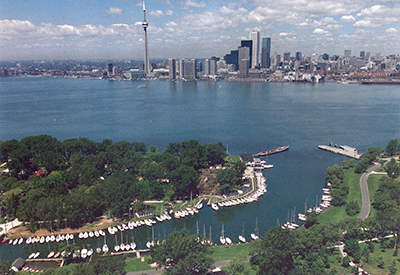 Seems that reports reached the Board that bad language was all too common around the club in the mid 1940s. The League of Decency was formed who carried tin banks into which were deposited 10 cents for every bad word uttered. Even the commodore, after inadvertently dropping a full bottle of Scotch, was said to have paid $4.30! Apparently the language cleaned up so fast that the league was soon abolished. E. Graham Dougall, a longtime member recounted that, “There was also a motion in the 1950s to not allow strippers in the Grand Hall!”
Seems that reports reached the Board that bad language was all too common around the club in the mid 1940s. The League of Decency was formed who carried tin banks into which were deposited 10 cents for every bad word uttered. Even the commodore, after inadvertently dropping a full bottle of Scotch, was said to have paid $4.30! Apparently the language cleaned up so fast that the league was soon abolished. E. Graham Dougall, a longtime member recounted that, “There was also a motion in the 1950s to not allow strippers in the Grand Hall!”
Their own tender, Algonquin Queen, was acquired and went into service in June 1968. It was replaced by the Algonquin Queen II in 2003. By 1979 The Rapids Queen was acquired and sunk as a break wall to cut the surge in the lagoon that accompanied a nor-wester. Although it made for better sleeping aboard your boat, there was absolutely no chance of getting any shut eye if your boat was moored under the Great Hall when one of the renowned parties took place.
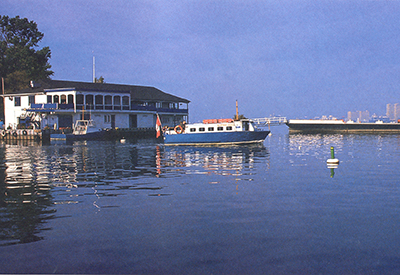 The self-help philosophy has forged long-lasting friendships that are passed down from generation to generation. Richard Slee, Communication Chair, says that their motto really should be, “Brute strength and ignorance over comes all!” This uniquely beautiful club is situated on an island in a park that is found in the largest urban car-free environment in North America. 95% of their fleet is sail and they have a vibrant learn to sail program for young and old for more than 60 years. A new Learn to Sail Centre, once more member designed, was completed in 2014, with member storage lockers next door. The “Snug Bar” on the ground floor of the clubhouse is open all year so members can skate or ski on the frozen lagoons. The dining room was added in 1964 and added to the Great Hall, it makes for ideal party conditions, for which they are famous.
The self-help philosophy has forged long-lasting friendships that are passed down from generation to generation. Richard Slee, Communication Chair, says that their motto really should be, “Brute strength and ignorance over comes all!” This uniquely beautiful club is situated on an island in a park that is found in the largest urban car-free environment in North America. 95% of their fleet is sail and they have a vibrant learn to sail program for young and old for more than 60 years. A new Learn to Sail Centre, once more member designed, was completed in 2014, with member storage lockers next door. The “Snug Bar” on the ground floor of the clubhouse is open all year so members can skate or ski on the frozen lagoons. The dining room was added in 1964 and added to the Great Hall, it makes for ideal party conditions, for which they are famous.
 “Crowd her north?” “Where’s the butterboard?” “Everyone on the pointy end!” “Clear the track!” “Follow the car!” are all shouts you will hear, along with mysterious words like, “King plank, cross-haul, ways and sleepers,” but they are close to the hearts of the members on their Marine Railway. It may not be co-incidental at all that in their 125th year, QCYC entertains more boats from visiting clubs than any other yacht club on Lake Ontario. Come join the fun and belong to one big family in a magical setting.
“Crowd her north?” “Where’s the butterboard?” “Everyone on the pointy end!” “Clear the track!” “Follow the car!” are all shouts you will hear, along with mysterious words like, “King plank, cross-haul, ways and sleepers,” but they are close to the hearts of the members on their Marine Railway. It may not be co-incidental at all that in their 125th year, QCYC entertains more boats from visiting clubs than any other yacht club on Lake Ontario. Come join the fun and belong to one big family in a magical setting.
Queen City Yacht Club; Box 401; Station A; Toronto, Ontario M5W 1C2; 416-203-0929; www.qcyc.ca
Photos:
Photo 1 – 1939: QCYC from Wards Island.
Photo 2 – 1910: QCYC Clubhouse base of York Street designed by E J Lennox.
Photo 3 – 1920: QCYC Clubhouse sinks into Toronto Harbour.
Photo 4 – 1968: QCYC launch of Algonquin Queen.
Photo 5 – 1989: QCYC Haulout.
Photo 6 – 1989: Skyshot of QCYC.
Photo 7 – 1990: QCYC Club house and the Algonquin Queen.
Photo 8 – 2012: Gunning in the new boats by Joshua Slee.






